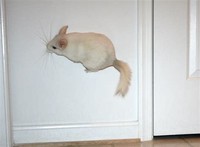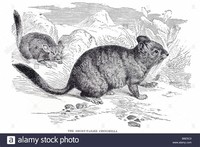Facts about Chinchilla

Chinchillas are naturally very skittish creatures and generally do not like to be held, although they can become very attached to their owners if they grow up without a cage mate.

The hair of the long-tailed chinchilla is about 2 to 4 centimeters (0.79–1.6 inches) long, with gray, white, and black bands; it is silky, extremely soft, and firmly adhered to the skin (Bennett 1835).

Chinchillas were once so abundant that early explorers reported seeing hundreds in a single day (AWI 1983).

The Chilean chinchilla (long-tailed chinchilla)is considered endangered by Chile (Vulnerable by IUCN), with Cofrй and Marquet (1999) assigning them the second highest conservation priority among Chilean mammals.

Chinchillas have four toes on the hind feet, with weakly developed hind claws, like the members of Lagidium, and unlike the three toes, with strong hind claws, of the strong-digging members of Lagostomus (Myers 2000).

Wild Chilean chinchillas feed on up to 24 plant species, mainly herbs and grasses.

The fur from chinchillas is popular in the fur trade due to its extremely soft feel, because of the density of hairs sprouting from each hair follicle.

Wild populations were rediscovered in 1978, and in 1983, Reserva Nacional Las Chinchillas was created in Chile.

Chinchillas have very large auditory bulllae relative to the other two genera.

Other medical research fields in which chinchilla is used as an animal model include study of Chagas disease, gastrointestinal diseases, pneumonia, and listeriosis, as well as of Yersinia and Pseudomonas infections.

The natural habitat of Chinchilla lanigera is barren, arid, and rugged areas of transverse mountain chains in north-central Chile that connect the coastal mountain ranges to the Andes.

Chinchillas are closely related to the viscachas of the same family, Chinchillidae.

Chinchillas are agile jumpers and can jump very high, up to 1.5 meters (5 feet).

Chinchillas are crepuscular or nocturnal and typically do not like to be disturbed during the day, which may make them less favorable as pets to some people.

Chapman and a group of men searched the mountain for three years and caught only eleven chinchillas.

In 1910, a treaty was signed between Chile, Bolivia, Argentina, and Peru, bringing the first international efforts to ban hunting and commercialization of chinchillas.

At this point, chinchillas were already close to extinction from humans killing them for the fur trade.

Ranched chinchilla pelts are considered superior to wild ones, and thus the demand for wild pelts has collapsed, although hunting (poaching) still continues (AWI 2004).

Once very abundant, chinchillas have been hunted nearly to extinction in the wild, valued for their very fine-textured, soft, and dense fur.

Mathias F. Chapman, a mining engineer from California, was working in Chile in 1918, when he purchased a chinchilla as a pet and took a liking to it.

Only 19 of 42 known colonies in Reserva Nacional Las Chinchillas currently are protected.

Chinchillas are predominantly herbivorous, feeding on grasses and seeds, but also will eat insects (Honeycutt 2004).

The long-tailed chinchilla is either nocturnal or crepuscular, and the short-tailed chinchilla is listed as nocturnal (Honeycutt 2004).

The pelt of a chinchilla is relatively small, so many animals must be killed to make a single coat.

The long-tailed chinchilla (Chinchilla lanigera) also is called the Chilean, coastal, or lesser chinchilla and is found in mountainous regions of Chile.

The long-tailed chinchilla has healthier population numbers, although it still is listed as Vulnerable by the IUCN, with a high risk of extinction.




